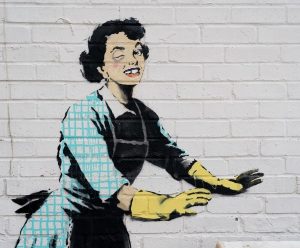
Love Is In The Bin, 2018
Spray-paint and acrylic on canvas mounted on board, framed by the artist.
Decommissioned, remote controlled shredding mechanism remains in the frame.
142x78x18 cm (60 x 30 7/8 x 7 inches)
Unique
Signed on the reverse
Sotheby’s London: 14 October 2021
GBP 18,582,000 / USD 25,457,340
NEW WORLD RECORD AT AUCTION

Prior Auction Result (as Girl and Balloon)
Sotheby’s London: 5 October 2018
GBP 1,042,000 / USD 1,365,482

Source: Sotheby’s
Undermining the establishment has always been at the heart of Banksy’s work, indeed, taking the artworld down a peg or two has particular currency in his imagery and ideology. It should therefore have come as no surprise that Banksy would mastermind perhaps the most extraordinary and elaborate feat of artistic subterfuge in recent history: the moment Girl with Balloon ‘self-destructed’ at Sotheby’s Contemporary Art Evening Auction on 5 October 2018.

But of course, this wasn’t an act of destruction, it was a moment of creation, a metamorphosis that transformed Banksy’s Girl with Balloon into an entirely new work of art that, in the words of BBC Arts Editor Will Gompetz, ‘will come to be seen as one of the most significant artworks of the early 21st Century.’
(Will Gompertz, ‘Will Gompertz on Banksy’s Love is in the Bin’, BBC News, 13 October 2018, online).

LEFT: @ MUSEUM FRIEDER BURDA, BADEN-BADEN, FEBRUARY – MARCH 2019.
IMAGE: © MUSEUM FRIEDER BURDA, BADEN-BADEN
RIGHT: BANKSY, LOVE IS IN THE BIN, STAATSGALERIE, STUTTGART, MARCH 2019 – FEBRUARY 2020, IMAGE: © STAATSGALERIE STUTTGART. A
Hidden within the ornate gilded frame surrounding Banksy’s famous spray-painted image was a shredding mechanism that began whirring and beeping as soon as Oliver Barker hammered down the gavel on the winning GBP 1,042,000 bid: a gobsmacked, audience looked on as the canvas began to pass through the frame in neatly cut strips. By the time the work was removed from view by Sotheby’s technicians, the machinery had stopped shredding halfway through the composition; a malfunction unexpected by the artist who, on his Instagram, claimed that “it worked in rehearsals every time”. Not knowing what was to come, Sotheby’s had placed the work at the end of one of the phone banks in a position reserved for works set to achieve high prices – a spot that played right into the artist’s hands as the event was immortalized on camera. In the days and weeks that followed Banksy’s shredded canvas became a cultural phenomenon: 30,000 news stories ensued globally, and the infamous painting became the subject of memes, political cartoons, protest placards, fridge magnets and t-shirts, to name only a few imaginative uses.
The Sunday Telegraph, 7 October 2018

Banksy’s Instagram increased by 1 million followers overnight as the artist’s series of short films documenting Girl with Balloon’s journey from studio to auction block shed some light on the machinations behind the now notorious event; and in the meantime, responding to a seemingly endless stream of press inquiries, Sotheby’s stated they had been well and truly ‘Banksy-ed’. Despite the speculation, Sotheby’s was entirely unaware of and uninvolved in Banksy’s plan – why, indeed, would an artist so focused on undermining the establishment collude with them? Following the auction, Pest Control – Banksy’s studio and authentication body – swiftly issued a new certificate and thereafter Sotheby’s opened its doors to no less than 5,000 visitors over the course of a rainy October weekend, all of whom had queued long stretches of time, as well as New Bond Street, to see the newly titled Love is in the Bin. The successful bidder was quick to realize the significance of the event, and while it was not the piece, they original planned to acquire, decided to keep the newly created artwork: “At first I was shocked”, they commented, “but I realized I would end up with my own piece of art history”. Three years on, nothing could be truer: a rebellious send up of the art market and a pin sharp contribution to the legacy of Marcel Duchamp, this piece utterly encapsulates the spirit of our time and the political, social, and artistic acuity of its author.
The Financial Times, 13 October 2018

The Guardian, 9 October 2018

During that memorable night, Banksy proved his artistic mettle on many fronts. Will Gompertz’s write up on Love is in the Bin was certainly quick to contextualize this work within the art historical framework to which it certainly belongs. Heir to a venerated legacy of anti-establishment art that began in the Modern era with DADA and Marcel Duchamp, Love is in the Bin evokes the same dissident principles that gave birth to Conceptual art and has since inspired artists to upend tradition via destructive statements or creative acts.
Robert Rauschenberg, Erased de Kooning Drawing
 Robert Rauschenberg, Erased de Kooning Drawing, 1953
Robert Rauschenberg, Erased de Kooning Drawing, 1953
San Francisco Museum of Modern Art
From Robert Rauschenberg’s erasure of a Willem de Kooning drawing, to Gustav Metzger’s radical Auto-Destructive acid paintings and Asger Jorn’s Modification Paintings, through to Martin Kippenberger’s repurposing of a 1973 Gerhard Richter Grau painting for one of his sculptures, Ai Wei Wei’s iconoclastic smashing of a Han Dynasty urn, Yves Klein’s infamous Saut dans le Vide, and even Lucio Fontana’s slashed canvases and Piero Manzoni’s notorious masterpiece Merda d’Artista, feats of destruction and dissidence have furnished artists with a means to poke and prod the system, to challenge our preconceptions, and to pose uneasy questions on artistry and value. When Girl with Balloon began shredding itself just after the hammer came down at auction, the well-heeled international artworld looked on agog and in disbelief as Banksy, via a masterstroke of radical performance art using his most famous and widely known image, began to pull the rug out from under the feet of an unwitting and centuries old art world establishment. Notorious, rebellious, cannibalistic, and utterly ingenious, Love is in the Bin is undoubtedly Banksy’s greatest work to date.

Banksy first came to our attention in the early 2000s with a renegade form of street art that looked to challenge the social order. Serving pithy social commentary via lightning-quick dark-humored punchlines in public places as controversial as the Segregation Wall in Palestine, Banksy became immensely popular with a broad cultural base. By the decade’s mid-point, his work began to veer increasingly towards more traditional artworld territories. Losing none of his satirical bent, however, his foray into the artworld establishment was to remain just as dissident and subversive, operating on paradoxical levels that further served to heighten the underlying political and satirical impetus of his art.
Building on a controversial DADAist legacy, Banksy has sought to poke fun at the art establishment – in his canon contemporary signs of social decline appear inserted into beloved artworks: traffic cones and abandoned shopping trollies litter Monet’s waterlilies, Titian’s Rokeby Venus is reimagined regarding her recently rhinoplasty reflection, while Michelangelo’s David wears a bullet proof vest. Using humor and art historical acumen Banksy undercuts the elite to elevate the everyday and shine a light on the grittier side of our contemporary moment.

In his first ‘gallery’ exhibition in 2006, Banksy’s defaced Monet and other vandalized oils were joined by a mischief of live rats; in 2005 he spray-painted the word ‘BORING’ in 20-feet high letters on the side of the National Theatre in London; and in 2004 he began infiltrating respected arts institutions by installing his own parodic works amongst the collections of esteemed museum collections including the British Museum, Tate Britain, The Museum of Modern Art New York, and the Louvre. Compounded by the artistic happening that brought forth Love is in the Bin, Banksy sets a new benchmark in institutional critique for the Twenty-First Century. Contra to the dry conceptualism spear-headed by Michal Asher and his influential CalArts legacy of the 1980s and 90s, Banksy couches his own institutional critique with a heavy dose of irony and humor that is immediately accessible and immensely popular. In this respect Banksy embodies a paradox: his work operates both inside and outside of the establishment; his persona is larger than life yet no one knows who he is; he courts mass appeal whilst commenting on potentially marginalizing political issues; he pushes the boundaries of taste yet is lauded by tastemakers. It is this very ambivalence, this ability to exist in two spheres at the same time, that gives his work its powerful resonance. To quote the Guardian art critic Jonathan Jones in response to Love is in the Bin, “[Banksy] is the artist who matters most right now” (Jonathan Jones, ‘Why putting £1m through the shredder is Banksy’s greatest work’, The Guardian, 8 October 2018, online).




